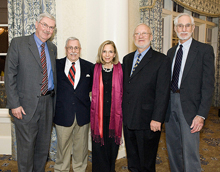Campus News
October 21, 2010
GDBBS looks back at growth

Brian Noe, Don Humphrey, Lisa Tedesco, Keith Wilkinson and Bob DeHaan
The Graduate Division of Biological and Biomedical Sciences celebrated its first two decades with an awards banquet Oct. 5 at Druid Hills Golf Club. The division, which trains about a third of all Emory PhDs, presented a number of awards for student achievement and faculty mentoring.
All three of the division’s former directors were keynote speakers: physiologist Don Humphrey; cell biologist Bob DeHaan, now emeritus; and cell biologist Bryan Noe, now dean of the graduate school at the University of Alabama, Birmingham.
Their remarks touched on several themes in how the division has evolved, including Emory’s success in obtaining training grants, changing demographics, adaptation to changing technology, and increasing attention to non-academic careers.
Starting from zero two decades ago, the GDBBS now supports graduate students from 18 different NIH training grants, contributing $1.4 million in stipends and a similar amount in tuition and fees.
Founding and funding
More recently, the division has been able to attract funding from the Burroughs Wellcome Fund for a “Molecules to Mankind” program, designed to integrate the studies of biology, behaviors, environments and populations; and from the Howard Hughes Medical Institute for a dual degree program providing a master’s degree in clinical and translational research to PhD students.
The percentage of underrepresented minorities in graduate biology programs at Emory has roughly doubled over this period (to around 17 percent) and the proportion of females has also increased, with a decrease in international students after 2001.
Admitting their first students in 1989, the division was initially modeled after an “umbrella” program at Washington University at St. Louis. Since then, many other research universities have adopted similar structures.
Describing the division’s founding, Humphrey explained that the drive for a structure connecting graduate biology programs in the late 1980s came from two factors: low application numbers to individual departments, and the need to give young scientists exposure to a wide range of techniques.
He said it was “no minor achievement” for Billy Frye, then dean of the graduate school and later provost, to convince department chairs to cede responsibility for the recruitment and education of graduate students to the new division. He also credited Eleanor Main, who became dean of the graduate school after Frye, as the administrator who was most responsible for the division’s survival in its early years. At the outset, the division’s staff had temporary offices in a teaching lab space and had to clear out every semester to make way for classes.
Becoming more flexible
Noe noted that in 1995, the division shifted from paper to e-mail for communication, and in 2000 began a switch to an online application process. Under Noe, the graduate division established a faculty stipend reserve fund, as a cushion against disruptions in grant funding. In 2001, the division began paying students’ health insurance. A student’s stipend, now $25,000, was $14,500 in 1994.
Also in the 1990s, the division shifted from guaranteeing certain number of slots to each graduate program, to a more flexible system where the number of slots is based on training grant availability and the proportion of applications received by each program.
Now, about 20 percent of first year rotations cross program lines, and roughly 10 percent of students choose dissertation advisers outside of the program they were admitted under.
While some other universities have an “open admissions” policy for graduate programs in biology, the current director of the GDBBS, biochemist Keith Wilkinson, said Emory’s system preserves more faculty involvement and sense of community among students and faculty in each graduate program, while maintaining significant flexibility and choice for students.
Career resources provided
Wilkinson also stressed the increased emphasis on providing career resources for student development, especially in the non-academic arena. In 2006, he started a monthly seminar series that hosts alumni and other outside speakers to discuss various career alternatives with the students.
Jacob Shreckengost, a sixth year neuroscience graduate student and member of the division’s student advisory council, said he was drawn to Emory because of the feeling of community and solidarity among students, and the collaborative nature of the scientific community.
“In my opinion, this is the greatest strength of the division, and one that should continue to be nurtured,” says Shreckengost.
He also said the GDBBS should continue to focus on improving areas that impact student life, such as health insurance, parking and transportation, child care, family leave policies, faculty mentor training and career counseling.
Quick Links
File Options
Related Information
GDBBS structure
The Graduate Division of Biological and Biomedical Sciences contains under its “umbrella” nine graduate programs:- • Biochemistry, Cell & Developmental Biology
- • Cancer Biologys (who will admit their first students next year)
- • Genetics and Molecular Biology
- • Immunology and Molecular Pathogenesis
- • Microbiology and Molecular Genetics
- • Molecular and Systems Pharmacology
- • Neuroscience
- • Nutrition and Health Sciences
- • Population Biology, Ecology
Students apply to, and enter through these graduate programs, but can switch programs or choose advisers outside their program boundaries.
